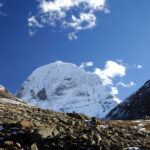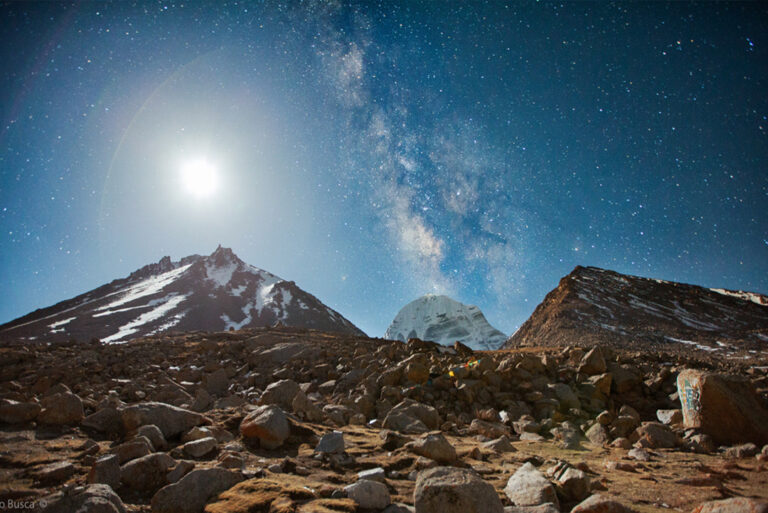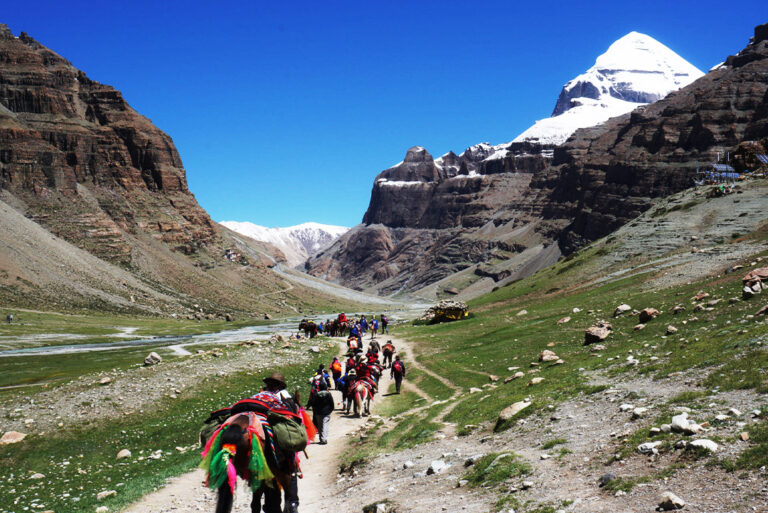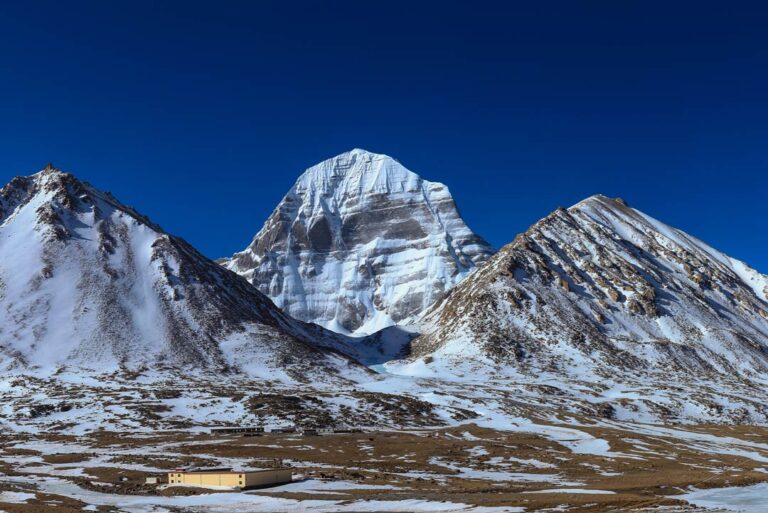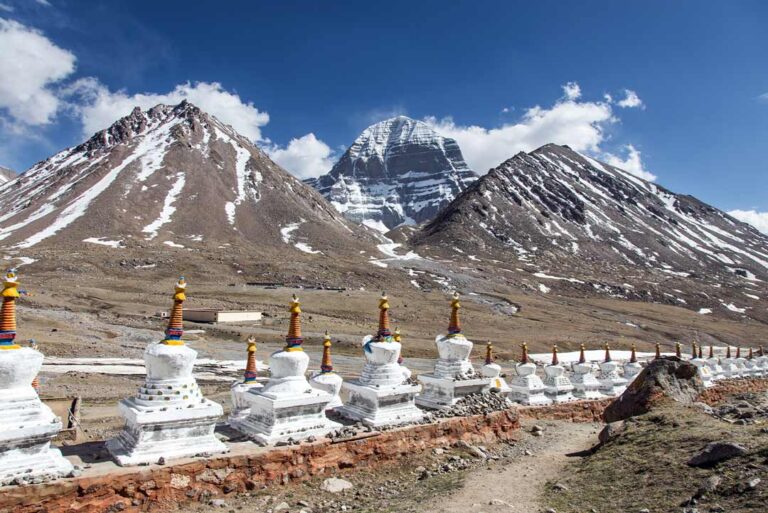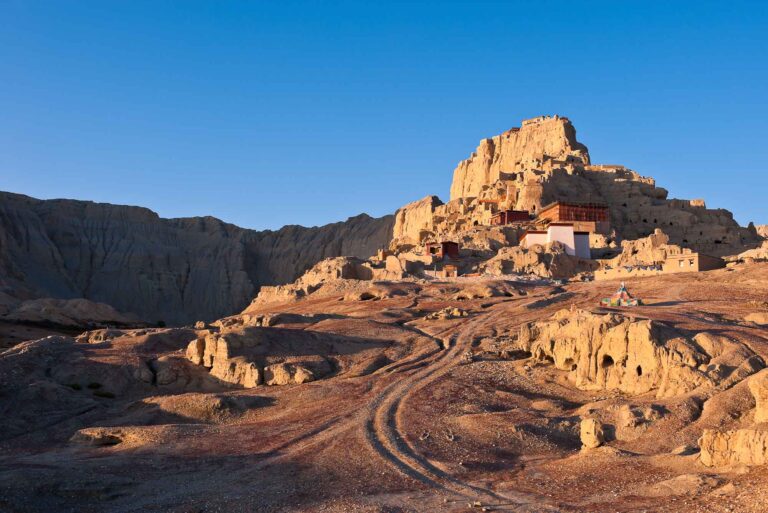Pashupatinath Temple located on the eastern outskirts of Kathmandu in Nepal. The Pashupatinath Temple stands as a testament to spirituality and ancient Hindu traditions. Renowned as a sacred site dedicated to Lord Shiva, particularly as Pashupati, the temple holds a magnetic allure for enthusiasts embarking on the revered Kailash Mansarovar Yatra. Its location, flanked by the sacred Bagmati River, adds a serene backdrop to the spiritual journey, creating an atmosphere where the divine connection intertwines with the natural surroundings. Pilgrims and tourists alike find solace in the temple’s ambiance, a sanctuary where rituals and traditions have echoed for centuries, fostering a deep connection with the divine.
The allure of Pashupatinath extends beyond its physical structure; it encapsulates the essence of Hinduism and the cultural richness of the Kathmandu Valley. As devotees engage in daily rituals and ceremonies, the temple becomes a living testament to the vibrant tapestry of faith. The proximity to Kailash Mansarovar adds a layer of significance, as many consider Pashupatinath a prelude to the sacred journey towards the abode of Lord Shiva. Whether it’s the intricate architectural details, the spiritual resonance within the inner sanctum, or the cultural vibrancy during festivals, Pashupatinath remains a focal point for those seeking a profound connection with divinity amidst the breathtaking landscapes of Nepal.

Historical Background:
With roots reaching back to the 5th century, the Pashupatinath Temple boasts a rich historical tapestry that intertwines with the very essence of Hinduism. The temple’s inception is shrouded in the mists of time, with its humble beginnings as a sacred site dedicated to Lord Shiva. Over the centuries, it has weathered the trials of history, emerging as a testament to unwavering faith and architectural ingenuity. The intricate carvings and structures within the temple complex narrate a story of devotion passed down through generations.
The evolution of Pashupatinath has not been without challenges, with seismic tremors leaving an indelible mark on its sacred grounds. The devastating earthquakes that struck the region have tested the mettle of this spiritual haven. However, the temple, much like the faith it represents, has shown remarkable resilience. Restoration efforts have been ongoing, with a commitment to preserving the historical and spiritual significance of this venerable site. The scars of earthquakes serve as a reminder of the temple’s enduring spirit and its ability to rise, phoenix-like, from the ashes, echoing the timeless nature of Hindu beliefs.
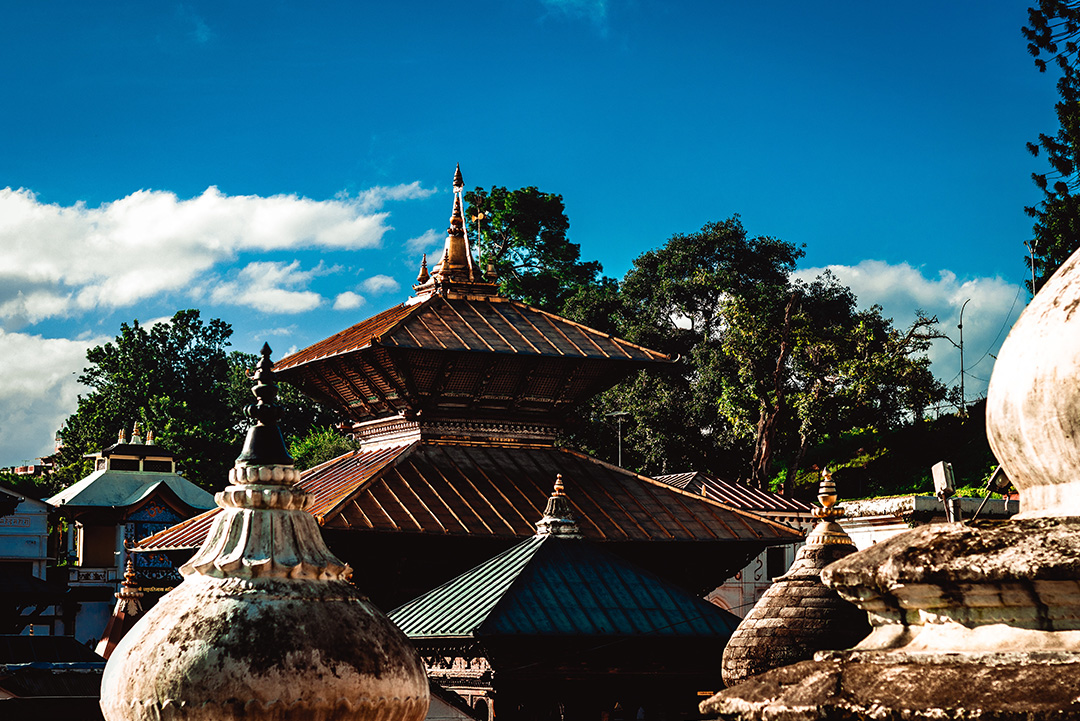
Architectural Splendor:
The pagoda-style design, adorned with copper roofs and gold embellishments, showcases the temple’s architectural grandeur. The intricate wooden carvings, depicting mythological stories and divine symbolism, add an ethereal charm to the structure. As sunlight dances on the gilded surfaces, the temple radiates a celestial glow, making it a visual masterpiece. The craftsmanship extends to the four main doors, elegantly covered with sheets of silver, inviting devotees into the sanctum with an air of reverence. The two-storied roof, crafted from copper and gilded with gold, not only reflects the opulence of Hindu architecture but also serves as a testament to the enduring devotion of those who contributed to its construction. The linga, positioned at the heart of the temple, takes center stage, surrounded by an aura of sacredness that permeates the entire complex.
Central to its structure is the linga, a sacred symbol representing Lord Shiva’s divine presence. The linga, an ancient emblem of cosmic energy, is meticulously bathed daily with milk and water from the sacred Bagmati River, signifying a ritualistic purification. Devotees from far and wide gather to witness this symbolic act, forging a connection between the divine and the earthly. The linga’s significance goes beyond its physical form; it embodies the essence of creation, preservation, and destruction—fundamental aspects of Lord Shiva’s cosmic dance. The temple’s architecture, with its fusion of artistic brilliance and spiritual symbolism, transforms the act of worship into a visually immersive experience, leaving an indelible impression on the hearts of pilgrims and visitors alike.
Deity and Legends:
Pashupati, the revered manifestation of Lord Shiva, holds sway over the devout with an aura of divine authority. Devotees flock to the Pashupatinath Temple, drawn by a profound sense of reverence for this benevolent deity. The spiritual resonance within the temple complex is heightened by the belief in Pashupati as the protector and guardian of all living beings on Earth. Pilgrims, particularly those embarking on the Kailash Mansarovar Yatra, view Pashupati as a guiding force on their spiritual journey, seeking solace in the deity’s transcendental presence.
Intriguing legends shroud Pashupatinath Temple, weaving tales of the deity’s enigmatic appearances. Ancient narratives tell of Pashupati taking the form of antelopes, adding an element of mystique to the temple’s sacred history. The discovery of the linga, a sacred symbol representing Lord Shiva, is embedded in these legends. It is said that the linga emerged as a result of divine events, further solidifying the temple’s significance as a place where the mystical and the earthly converge. Pilgrims and visitors alike are captivated by the spiritual energy that emanates from these tales, fostering a deeper connection to the divine within the sacred precincts of Pashupatinath.
Priests and Rituals:
Exclusive access is granted to a select few priests, namely the Bhatta and Rajbhandaris, who conduct daily rituals and ceremonies. Devotees are captivated by the sacred practices performed within the hallowed premises. The Bhatta, a hereditary priestly class, and the Rajbhandaris, appointed by the king in ancient times, hold the responsibility of maintaining the sanctity of Pashupatinath. Their lineage traces back generations, with intricate knowledge passed down, ensuring the rituals are conducted with precision and devotion. These priests play a pivotal role in the spiritual rhythm of the temple, orchestrating ceremonies that bridge the earthly realm with the divine. Their exclusive role grants them the authority to interact directly with the sacred linga, symbolizing their unique connection to the spiritual energy emanating from Pashupatinath.
The rituals conducted by the priests are a symphony of ancient traditions, echoing through the temple’s sacred corridors. From the rhythmic chants that resonate with Vedic hymns to the elaborate Abhisheka ceremonies, each ritual is a tapestry woven with faith and reverence. Devotees, both local and international, witness these rituals with awe, feeling a profound connection to the divine. The rituals serve not only as religious practices but also as a cultural inheritance that breathes life into the spiritual legacy of Pashupatinath. As the priests meticulously perform these rites, the temple becomes a living testament to the enduring power of faith and the timeless beauty of Hindu traditions.
Spiritual Experience:
The spiritual ambiance of Pashupatinath Temple is most palpable during the morning and evening rituals. As the first light of dawn bathes the temple complex, and the last rays of the sun bid farewell, the air becomes infused with devotion and tranquility. The rhythmic chants, the fragrance of incense, and the ethereal glow of oil lamps create a serene atmosphere, transporting devotees into a realm where the divine feels tangibly close. This unique connection established through the rituals becomes a spiritual anchor for those who seek solace, guidance, or simply a moment of communion with the divine. The interplay of light and shadow, coupled with the resonating sounds of prayers, transforms the spiritual experience into a sensory journey that lingers in the hearts of those fortunate enough to partake in this sacred rhythm of life.
Temple complex:
The sprawling temple complex of Pashupatinath is a microcosm of spiritual richness, adorned with mini-temples that add layers of significance to the devotees’ pilgrimage. Among these, the Vaishnava temple stands as a testament to the harmonious coexistence of various Hindu sects within the sacred premises. Devotees often find solace and diversity in the intricate architecture and varied deities represented in these mini-temples. Additionally, the Guhyeshwari Temple, located in close proximity, holds a mystic aura dedicated to Sati Devi, the consort of Lord Shiva. Pilgrims believe that paying homage to Guhyeshwari brings blessings and spiritual fulfillment.
The aftermath of the 2015 earthquake, while leaving visible scars on some outer structures, also serves as a poignant reminder of the temple’s resilience and the collective efforts invested in its restoration. The scars, now etched in the stone and wood, tell a tale of survival and reconstruction, symbolizing the unyielding spirit of Pashupatinath and its enduring role as a beacon of faith. Despite the challenges, the temple complex stands today as a living heritage, inviting visitors to witness not only its architectural grandeur but also the strength derived from the bonds of devotion and reconstruction that bind its sacred grounds.
Festivals:
Teej festival, another significant celebration, adds a feminine touch to the temple’s cultural vibrancy. Dedicated to the goddess Parvati, this festival is marked by women fasting, singing traditional songs, and performing ceremonial dances. The temple becomes a canvas of colors, with women adorned in vibrant attire offering prayers for the well-being of their spouses. The divine union of Lord Shiva and Goddess Parvati is commemorated through these rituals, fostering a sense of unity and shared devotion among the worshippers. Teej at Pashupatinath is not merely a religious event but a cultural extravaganza that showcases the rich tapestry of traditions, reinforcing the temple’s role as a living heritage site.
Access and Timings:
The Pashupatinath Temple, a spiritual haven in Kathmandu, beckons visitors through its four entrances, each imbued with its unique significance. The western entrance, known as the “Rudra Sampradaya,” is exclusively reserved for Hindus, emphasizing the sacred nature of this path. On the contrary, the eastern entrance welcomes individuals of all faiths, allowing them to soak in the spiritual atmosphere without venturing into the inner sanctum. The southern gate, named the “Unmatta Bhairava,” is traditionally associated with intense religious practices, while the northern gate, the “Hanuman Dhoka,” invites devotees with its historical and mythological relevance. These distinct entry points reflect the temple’s openness to diverse spiritual seekers, fostering an inclusive ambiance.
Understanding the rhythm of the temple requires an appreciation for its seasonal variations in timings. As the sun paints the sky with hues of dawn, the temple opens its inner sanctum at 4 am, welcoming the early birds seeking spiritual solace. The sanctity of this timing is heightened during festivals and special occasions when the divine aura is palpable. However, as the day unfolds, the temple gracefully adapts its accessibility, ensuring a harmonious blend between the influx of devotees and the need to preserve the serene sanctum. By navigating the ebb and flow of these temporal nuances, visitors can orchestrate their pilgrimage, savoring moments of tranquility amidst the spiritual symphony that is Pashupatinath.
Abhisheka:
The inner sanctum, housing the sacred linga, becomes the focal point during Abhisheka, a poignant ritual that unfolds as a profound spiritual experience. The ceremony involves the anointment of the linga with various sacred substances, including milk, ghee, honey, and holy water. Devotees, clad in traditional attire, gather in the sanctum to actively participate in the ceremonial offerings. The rhythmic chanting of Vedic hymns creates an ethereal atmosphere, heightening the connection between the worshipper and the divine. The fragrance of incense permeates the air, and the soft glow of oil lamps adds to the mystical ambiance. As the ritual progresses, the energy within the temple intensifies, creating a collective spiritual journey that transcends the material realm.
Participating in the Abhisheka ceremony at Pashupatinath is not merely a ritualistic act; it is an immersive experience that deepens one’s spiritual understanding. Devotees, with folded hands and bowed heads, offer their prayers with unwavering devotion. The pouring of sacred substances symbolizes the purification of the soul and the divine blessings bestowed upon the worshippers. The shared participation in Abhisheka fosters a sense of community and unity among the devotees, creating an enduring memory etched in the sacred corridors of Pashupatinath Temple.
Surrounding Attractions:
The ethereal charm of Pashupatinath Temple extends beyond its sacred precincts, encompassing nearby attractions that enrich the spiritual experience. Guhyeshwari Temple, situated in close proximity, stands as a revered companion to Pashupatinath. Dedicated to Sati Devi, the consort of Lord Shiva, this 17th-century temple, also known as Guhyeshwari, carries an aura of mysticism. Its sanctity is underscored by strict restrictions, allowing only Hindus to enter its premises. Pilgrims often embark on a holistic journey, seamlessly transitioning from the divine ambiance of Pashupatinath to the spiritual resonance emanating from Guhyeshwari Temple.
Adjacent to the temple complex, the Gorakhnath Temple emerges as a towering symbol of devotion to Lord Shiva. Dating back to the 11th century, this Shiva temple is renowned not only for its religious significance but also for the surrounding forest landscape and the presence of passing deer, adding a touch of serenity to the spiritual enclave. Moreover, the temple complex boasts the largest Nandi statue, the divine bull and vehicle of Lord Shiva, sculpted from brass. This colossal representation of Nandi stands as a testament to the intricate artistry of the temple’s surroundings, creating a harmonious ensemble that resonates with the spiritual narrative of Pashupatinath. The interplay of these structures adds layers of cultural depth and symbolic meaning, providing a comprehensive and enriching pilgrimage experience for devotees and visitors alike.
Viewpoints and Ghats:
A hilltop viewpoint, perched strategically near Pashupatinath Temple, grants visitors a mesmerizing panorama of the entire temple complex. As the morning sun bathes the intricate pagoda-style structures in a golden hue, devotees and tourists alike revel in the spiritual beauty that unfolds before them. The vantage point not only captures the architectural grandeur but also allows a contemplative space for individuals to absorb the divine energy that emanates from the temple. It’s a place where spirituality meets visual splendor, offering a unique perspective that enhances the overall pilgrimage experience.
The ghats along the sacred Bagmati River play a dual role in the Pashupatinath narrative. While they serve as platforms for poignant cremation ceremonies, they also provide a serene backdrop for various religious rituals. These riverbanks, etched with cultural significance, witness the final earthly journey of departed souls. The rituals, carried out with reverence and tradition, create a poignant yet tranquil atmosphere. The Bagmati River, considered holy in Hinduism, becomes a conduit for the spiritual transition of the departed, and observing these ceremonies offers a profound glimpse into the circle of life and death. The eastern ghats, in particular, emanate a peaceful aura, inviting reflection and contemplation amidst the ritualistic activities that unfold along the river’s edge.
Bachhareshwari Temple:
The Bachhareshwari Temple’s significance goes beyond its artistic embellishments. Its connection to tantric figures intricately weaves into the broader spiritual journey of Pashupatinath. As devotees traverse the temple grounds, they are enveloped in an atmosphere where the divine and the sensual coalesce, inviting contemplation and introspection. The temple stands not only as a physical structure but as a portal to explore the complexities of human spirituality, where the interplay of art, symbolism, and devotion converges into a harmonious tapestry. In the sacred precincts of Bachhareshwari Temple, visitors find not just an architectural marvel but a profound exploration of the human quest for the divine.
Religious Market:
The vibrant religious market surrounding Pashupatinath Temple is a microcosm of spiritual commerce, where the sacred and the material converge. Stalls adorned with colorful trinkets, prayer beads, and religious artifacts create a visual feast for visitors. Pilgrims and tourists alike can immerse themselves in the rich tapestry of cultural exchanges as they peruse intricately crafted souvenirs and ritual items. The market becomes a lively arena where devotees can acquire tokens of their spiritual journey, from traditional clothing to religious paraphernalia. The air is filled with the aromatic essence of incense, and the market’s energy mirrors the fervor of those who visit the temple seeking not only divine blessings but also tangible reminders of their spiritual experience.
Cultural Exchange:
Beyond the transactional aspects, the religious market facilitates a unique cultural exchange. Visitors engage with local vendors, gaining insights into the significance of various items and the cultural context surrounding them. The market becomes a bridge between the sacred rituals within the temple and the tangible expressions of faith that individuals carry with them. This bustling hub allows for conversations that transcend language barriers, fostering a deeper understanding of the diverse traditions encapsulated within the spiritual journey. As visitors explore the market’s labyrinthine alleys, they find themselves not only acquiring religious artifacts but also becoming part of a broader narrative where spirituality and commerce coalesce harmoniously.
Pashupatinath Temple and Kailash Mansarovar Yatra:
Pashupatinath Temple stands as the spiritual gateway for those embarking on the sacred journey of Kailash Mansarovar Yatra. As a starting point for pilgrims on this transformative expedition, the temple radiates a profound energy that sets the tone for the spiritual sojourn ahead. Pilgrims, adorned in traditional attire and equipped with ritual items acquired from the vibrant religious market, gather at Pashupatinath to seek blessings before venturing towards the revered Mount Kailash. The temple not only serves as a place of worship but also as a cultural crossroads, where the spiritual aspirations of those undertaking the Yatra blend seamlessly with the vibrant offerings of the surrounding market.
The Kailash Mansarovar Yatra, facilitated by esteemed agencies like Kailash Yatra Co., finds its roots in the spiritual ethos emanating from Pashupatinath Temple. Pilgrims, having absorbed the divine energy of Pashupatinath, set forth on a journey that transcends geographical boundaries. The Yatra becomes a transformative experience, where the spirituality nurtured at the temple is carried through the rugged terrains to the pristine waters of Lake Mansarovar. Pashupatinath Temple, with its rich history and sacred ambiance, becomes the beacon that guides pilgrims on their path towards Mount Kailash, creating an intricate connection between the spiritual essence of Nepal and the sacred landscapes of Tibet.
Conclusion:
Pashupatinath Temple, with its spiritual allure and architectural grandeur, stands as a beacon of Hindu faith. Nestled on the banks of the sacred Bagmati River, it not only serves as a physical embodiment of devotion to Lord Shiva but also encapsulates the rich tapestry of Nepal’s cultural and religious heritage. The pagoda-style temple, adorned with intricate wooden carvings and a gilded roof, is a testament to the skill and artistry of ancient craftsmen. Its magnetic pull extends beyond devout pilgrims, drawing inquisitive tourists seeking a profound connection with the divine.
As pilgrims and tourists alike partake in its rituals and absorb the sacred ambiance, the temple becomes a vibrant hub of spiritual energy. The rhythmic chants, the aroma of incense, and the vivid rituals create an immersive experience that transcends the boundaries of religious affiliations. The temple’s significance is not confined to its physical structure; it resonates in the hearts of those who traverse its hallowed grounds. Whether witnessing the grandeur of Maha Shivaratri celebrations or quietly contemplating by the Bagmati River, every visitor contributes to the ongoing narrative of Pashupatinath, making it a living testament to the enduring power of faith and cultural identity in the heart of Nepal.
FAQs on Pashupatinath Temple:
1) Is Pashupatinath Temple open to visitors of all religions?
While Pashupatinath Temple warmly welcomes Hindus and Buddhists, its inner sanctum remains restricted for those outside these religious affiliations. The temple, a symbol of devotion and cultural richness, extends an invitation to people of diverse backgrounds to witness its grandeur and absorb the spiritual energy that permeates the air. However, in adherence to its sacred traditions, access to the inner sanctum is reserved for followers of Hinduism and Buddhism. Visitors from other religions are graciously accommodated to observe and appreciate the temple’s magnificence from a respectful distance, allowing them to partake in the cultural mosaic that defines this sacred site on the banks of the Bagmati River.
2) What is the significance of the linga in Pashupatinath Temple?
The linga in Pashupatinath Temple holds profound significance in Hindu cosmology. Representing Lord Shiva’s divine presence, the sacred stone symbolizes the unmanifest aspect of the deity. Devotees believe that the linga embodies the cosmic energy and creative force of Shiva, and it serves as a focal point of worship and rituals within the temple. The intricate carvings and adornments on the linga add to its sanctity, with each face of the stone bearing significance to different aspects of Shiva, including Sadyojata, Vamadeva, Tatpurusha, Aghora, and Ishana. The linga becomes a conduit for spiritual connection, and during the abhisheka, devotees offer milk and water from the Bagmati River, engaging in a ritual that transcends the material realm and invokes the divine essence of Lord Shiva
3) Can visitors participate in the Abhisheka ceremony?
Yes, devotees are not mere spectators at Pashupatinath; they are active participants in the divine rituals that unfold within its sacred precincts. The Abhisheka ceremony, a revered practice where the deity is anointed with sacred substances, is open to the faithful. Visitors have the unique opportunity to engage in this ancient tradition, contributing their devotion through offerings of milk and water from the holy Bagmati River. The inclusive nature of Pashupatinath fosters a sense of community and shared spirituality, allowing devotees from diverse backgrounds to connect with the divine energy that permeates the temple. As the ceremony unfolds, the boundaries between observer and participant blur, creating an atmosphere where the sacred and the worldly coalesce in a harmonious dance of devotion.
4) When is the best time to visit Pashupatinath Temple to avoid crowds?
Early mornings and weekdays are generally less crowded, providing a more serene experience for visitors. The tranquil dawn hours unveil a different facet of the temple, where the soft light accentuates the intricate details of the architecture, and the air is filled with a sense of quiet devotion. Choosing to explore Pashupatinath during weekdays allows for a more intimate encounter with the spiritual essence of the site, away from the bustling crowds that often gather during festivals and special events. This strategic timing ensures that pilgrims and tourists can immerse themselves in the sacred atmosphere, absorbing the energy of the temple at their own pace while avoiding the peak hours of visitation.
5) Are there specific guidelines for interacting with sadhus and priests?
Engaging with sadhus and priests in the sacred precincts of Pashupatinath Temple offers a unique cultural experience, but it is crucial to approach them with utmost respect. These ascetic yogis, with their distinctive appearance and spiritual pursuits, are often open to interactions with visitors. Seek permission before capturing photographs, acknowledging that their spiritual practices are personal and sacred. A genuine interest in their way of life may lead to insightful conversations, providing a deeper understanding of Hindu traditions and philosophies. Embracing cultural exchanges fosters a harmonious atmosphere and enhances the overall spiritual journey within the temple complex.

